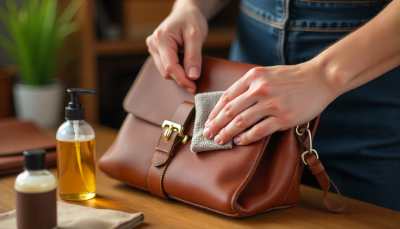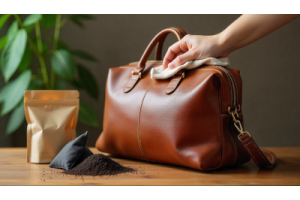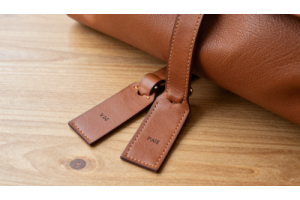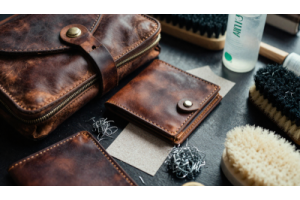HimalayanBits Leather Care: How to Remove Stains Easily

HimalayanBits Leather Care: How to Remove Stains Easily
Keeping your leather looking fresh shouldn’t be stressful — and yes, we’ve made mistakes before with complicated routines, but this guide fixes that. At HimalayanBits, we believe leather care should feel simple, quick, and totally doable at home. Whether it’s a spill, a scratch, or a stubborn mark, you can clean your leather safely with the right steps. This introduction walks you through easy, practical stain-removal tips so your bags, wallets, and accessories stay smooth, spotless, and long-lasting. Clear steps, no jargon — just effective leather care you can trust.
Table Of Contents
- 1. Introduction – Simple Leather Stain Removal
- 2. Common Types of Leather Stains
- 3. Preparing Your Leather Before Cleaning
- 4. Easy Methods to Remove Different Stains
- 5. Safe DIY Solutions for Quick Cleaning
- 6. Mistakes to Avoid While Cleaning Leather
- 7. How to Protect Leather from Future Stains
- 8. Recommended Leather Care Products
- 9. Conclusion
- 10. FAQs – Leather Stain Removal Made Easy
1. Introduction – Simple Leather Stain Removal
Leather looks luxurious, but stains can show up fast — spills, smudges, makeup, oil, you name it. And yes, we’ve all used the wrong cleaning tricks before, but this guide cuts out those mistakes. At HimalayanBits, we keep leather care simple, safe, and practical. You don’t need fancy tools or harsh chemicals; you just need the right steps. This section walks you through easy ways to remove stains without damaging the texture, color, or finish of your leather. Clear, quick, and beginner-friendly — so your favourite leather pieces stay clean, soft, and beautiful for years.
- Leather can stain easily from spills, makeup, oil, or everyday use.
- Many people use the wrong cleaning methods, which damage the leather.
- HimalayanBits focuses on simple, safe, and effective leather care.
- You don’t need harsh chemicals — just the right steps and gentle cleaning.
- This guide helps you remove stains without harming the leather’s texture or color.
- The goal is to keep your leather clean, soft, and looking new for years.
Tip
A simple tip for easy leather stain removal is to act quickly and treat the spot before it settles. Always start by testing any cleaner on a small hidden area, then gently blot the stain instead of rubbing, because rubbing pushes the stain deeper into the leather. Use a soft microfiber cloth and avoid harsh chemicals like bleach or alcohol, which can permanently damage the surface. If the stain is oily, sprinkle a little cornstarch to absorb the excess before wiping it off. Keep the leather slightly moisturized during the process, and always let it air-dry naturally. This gentle approach keeps your leather clean, smooth, and protected while safely lifting the stain.
2. Common Types of Leather Stains
Leather can get stained in many ways, and knowing the type of stain helps you treat it correctly. Water stains appear as dark or light patches from spills or rain and usually need gentle blotting. Oil and grease stains, from food or skin oils, can leave dark marks that penetrate quickly. Ink stains, often from pens or markers, are tricky because they can permanently alter leather if not treated carefully. Makeup stains, like foundation or lipstick, sit on the surface and require soft cleaning to avoid smearing. Dirt and mud stains can dry into the leather, so they need to be brushed off gently before wiping. Food and beverage stains, such as coffee, wine, or sauces, can soak in fast, so prompt blotting is essential. Finally, sweat and body oils from regular use may gradually darken areas like handles or seats, and they are best managed with regular cleaning and conditioning.
- Water Stains: These appear as dark or light patches on leather from spills or rain. Always blot gently with a soft cloth and avoid rubbing, which can damage the leather surface.
- Oil and Grease Stains: Caused by food, lotions, or natural skin oils, these stains can penetrate leather quickly. Sprinkle cornstarch or talcum powder to absorb oil before gently brushing it away.
- Ink Stains: From pens or markers, ink stains are challenging because they can permanently alter leather. Dab gently with a leather-safe ink remover or mild solution, avoiding harsh scrubbing.
- Makeup Stains: Lipstick, foundation, or powder often sit on the leather surface. Use a soft, damp cloth or a mild soap solution to lift the stain carefully without spreading it further.
- Dirt and Mud Stains: Dried dirt or mud can scratch leather if rubbed. Let it dry, then use a soft brush to remove excess particles before wiping gently with a damp cloth.
- Food and Beverage Stains: Spills like coffee, wine, or sauces soak into leather fast. Blot immediately with a clean cloth and follow with gentle cleaning to prevent discoloration.
- Sweat and Body Oils: Frequent handling, especially on handles or seats, can gradually darken leather. Regular cleaning and conditioning help maintain even color and softness.
| Stain Type | Cause | Effect on Leather | Quick Tip for Removal |
|---|---|---|---|
| Water Stains | Spills, rain, or moisture exposure | Dark or light patches on leather surface | Blot gently with a soft cloth, avoid rubbing |
| Oil & Grease | Food, lotions, skin oils | Dark marks that penetrate quickly | Use cornstarch to absorb oil, then brush gently |
| Ink Stains | Pens, markers | Permanent discoloration if untreated | Dab with leather-safe ink remover or mild solution |
| Makeup Stains | Lipstick, foundation, powder | Surface marks that can smear | Use a soft damp cloth or mild soap solution |
| Dirt & Mud | Dried soil or dust | Can scratch leather if rubbed | Brush off dried dirt before gently wiping |
| Food & Beverage | Coffee, wine, sauces | Quickly soaks into leather and discolors | Blot immediately, then clean gently |
| Sweat & Body Oils | Frequent handling, natural body oils | Gradual darkening, especially on handles | Regular cleaning and conditioning to maintain color |
3. Preparing Your Leather Before Cleaning
Before tackling any stain, preparation is key to keeping your leather safe and looking its best. Leather is delicate, and improper handling can cause scratches, discoloration, or even permanent damage. This section guides you through the essential steps to get your leather ready for cleaning, including removing surface dust, testing cleaning methods, and choosing the right tools. By preparing your leather correctly, you ensure that the stain removal process is effective, gentle, and protects the leather’s texture, color, and overall quality.
- Remove Surface Dust: Use a soft, dry cloth or microfiber duster to gently wipe away dust and loose particles before cleaning. This prevents scratches during the cleaning process.
- Test Cleaning Solution: Always try your chosen cleaning method on a small, hidden area of the leather first to ensure it doesn’t cause discoloration or damage.
- Choose the Right Tools: Use soft cloths, brushes with soft bristles, or sponges designed for leather to avoid scratching or roughing up the surface.
- Work in a Well-Lit Area: Proper lighting helps you see stains clearly and ensures that you clean thoroughly without missing spots.
- Keep Leather Dry: Avoid soaking the leather; only use slightly dampened cloths when necessary. Excess moisture can warp or stain the material.
- Condition If Needed: For older or dry leather, applying a small amount of leather conditioner before cleaning can prevent cracking and make cleaning easier.
- Gather All Supplies: Have all your tools, cleaning solutions, and cloths ready before starting, so you can work efficiently without interruptions.
4. Easy Methods to Remove Different Stains
Different types of leather stains need different approaches to avoid damage. For water stains, gently blot the affected area with a soft, dry cloth and let it air-dry; avoid rubbing, which can leave marks. Oil and grease stains respond well to absorption methods — sprinkle cornstarch or talcum powder on the stain, let it sit for a few hours, then brush it off carefully. Ink stains are tricky; dab lightly with a leather-safe ink remover or a mild soap solution, never rub aggressively. Makeup stains like lipstick or foundation should be lifted using a slightly damp cloth or mild soap, working from the outside of the stain inward. For dirt or mud, allow it to dry completely before brushing off excess particles, then wipe gently with a damp cloth. Food and beverage spills should be blotted immediately with a clean cloth, then cleaned with mild soap if needed. Finally, sweat and body oils benefit from regular cleaning and conditioning to maintain even color and prevent dark spots. Following these methods ensures your leather stays clean, soft, and long-lasting without risking damage.
- Water Stains: Gently blot the affected area with a soft, dry cloth and let it air-dry. Avoid rubbing to prevent permanent marks.
- Oil & Grease Stains: Sprinkle cornstarch or talcum powder on the stain, leave it for a few hours to absorb the oil, then brush it off carefully.
- Ink Stains: Dab lightly with a leather-safe ink remover or mild soap solution. Avoid rubbing aggressively, which can spread the stain.
- Makeup Stains: Use a slightly damp cloth or mild soap to lift stains like lipstick or foundation, working from the outside of the stain inward.
- Dirt & Mud: Let mud or dirt dry completely, then brush off excess particles before gently wiping with a damp cloth.
- Food & Beverage Spills: Blot immediately with a clean cloth, then clean gently with mild soap if necessary to avoid discoloration.
- Sweat & Body Oils: Regular cleaning and conditioning help maintain even color and prevent dark spots from frequent handling.
5. Safe DIY Solutions for Quick Cleaning
Even with the best intentions, it’s easy to damage leather while trying to clean it. Using harsh chemicals, scrubbing too hard, or applying too much water can leave stains, scratches, or permanent discoloration. Many people also skip testing cleaning solutions on hidden areas or ignore the importance of gentle tools. This section highlights the most common mistakes and explains how to avoid them, so you can protect your leather while keeping it spotless, soft, and long-lasting. Understanding these pitfalls ensures your stain-removal efforts are effective and safe for every leather item.
- Mild Soap & Water: Mix a small amount of gentle soap with water. Dampen a soft cloth, wipe the stained area gently, and then dry with a clean cloth. Works well for light stains and dirt.
- Cornstarch or Talcum Powder: Sprinkle on oily or greasy stains, leave for a few hours to absorb the oil, then brush off gently. Ideal for food and body oil stains.
- White Vinegar Solution: Mix equal parts white vinegar and water. Dampen a cloth and blot the stain carefully. Helps remove mild discoloration and surface marks.
- Rubbing Alcohol (for Ink Only): Apply sparingly with a cotton swab on ink stains. Dab gently, don’t rub, and wipe off immediately. Test on a hidden area first.
- Baking Soda: Sprinkle on fresh spills like oil or sauce, leave for a few hours, then wipe off. Absorbs moisture and prevents stains from setting.
- Leather Conditioner: After cleaning, apply a small amount of leather conditioner to restore softness and prevent cracks. Especially useful for older or dry leather.
| Mistake | Why It’s Harmful | How to Avoid It |
|---|---|---|
| Using Harsh Chemicals | Can discolor or damage leather’s natural texture | Use mild soap or leather-safe cleaning products only |
| Scrubbing Too Hard | May scratch or wear down the leather surface | Gently blot or wipe stains with a soft cloth |
| Excess Water | Can warp, stain, or create watermarks on leather | Use slightly damp cloths, not soaking wet |
| Skipping a Test Area | Unexpected reactions can cause permanent damage | Always test cleaning solutions on a hidden spot first |
| Ignoring Leather Conditioning | Leather can dry out and crack over time | Apply a small amount of conditioner after cleaning |
| Using Rough Tools | Scratches and abrasions may appear on the leather | Use microfiber cloths or soft brushes only |
6.Mistakes to Avoid While Cleaning Leather
Even with careful intentions, leather is delicate and can be easily damaged during cleaning. Common errors like using harsh chemicals, scrubbing too hard, or applying too much water can cause stains, scratches, or permanent discoloration. Many people also skip testing cleaning solutions on hidden areas or ignore using gentle tools. This section highlights the most common mistakes to avoid, helping you clean leather safely and effectively while maintaining its texture, color, and overall quality. Understanding these pitfalls ensures your leather remains spotless, soft, and long-lasting.
- Using Harsh Chemicals: Strong cleaners like bleach or ammonia can discolor or damage leather. Always use mild soap or leather-safe products.
- Scrubbing Too Hard: Aggressive scrubbing can scratch or wear down the leather surface. Gently blot or wipe instead.
- Using Excess Water: Soaking leather can warp it, cause watermarks, or create stains. Always use slightly damp cloths, not soaking wet ones.
- Skipping a Test Area: Applying a new cleaner without testing can lead to unexpected damage. Always test on a small hidden area first.
- Ignoring Leather Conditioning: Leather can dry out and crack over time if not conditioned. Apply a leather conditioner regularly after cleaning.
- Using Rough Tools: Brushes or cloths that are too rough can scratch the leather. Use microfiber cloths or soft-bristled brushes only.
- Delaying Stain Treatment: Waiting too long to clean a stain can make it permanent. Address spills and stains immediately for best results.
7.How to Protect Leather from Future Stains
Protecting leather from stains is just as important as removing them. Regular care, preventive measures, and proper storage can greatly extend the life and beauty of your leather items. This section explains simple, practical strategies to shield leather from spills, oils, dirt, and everyday wear. By taking proactive steps, you ensure your leather maintains its texture, color, and softness, keeping it looking fresh, polished, and luxurious for years to come.
- Apply Leather Conditioner Regularly: Conditioning keeps leather soft, supple, and resistant to cracks, making it less likely to absorb stains.
- Use a Leather Protector Spray: Protective sprays create a barrier against water, oil, and dirt. Always test on a hidden area first.
- Store Leather Properly: Keep items in a cool, dry place away from direct sunlight and heat sources to prevent fading, drying, or warping.
- Handle with Clean Hands: Oils, lotions, and dirt from hands can transfer to leather surfaces, causing stains over time.
- Avoid Contact with Dirty Surfaces: Placing leather on dusty or rough surfaces can lead to dirt buildup and potential scratches.
- Rotate Usage: Avoid using the same leather item every day. Rotating items prevents uneven wear and reduces sweat and oil buildup.
- Immediate Spot Cleaning: Address spills and stains as soon as they happen to prevent them from setting in.
8. Recommended Leather Care Products
Choosing the right products is essential for keeping your leather clean, soft, and long-lasting. With so many options available, it can be overwhelming to know which cleaners, conditioners, and protective sprays are safe and effective. This section highlights trusted leather care products that help remove stains, nourish the material, and protect it from future damage. Using the right products not only maintains the leather’s appearance but also extends its life, keeping your items looking fresh, polished, and luxurious for years.
- Leather Cleaner: Gently removes dirt, dust, and light stains without damaging the leather. Ideal for regular maintenance of bags, shoes, jackets, and furniture.
- Leather Conditioner: Restores softness and suppleness, prevents cracking, and nourishes older or dry leather. Use after cleaning to maintain texture and color.
- Leather Protector Spray: Creates a barrier against water, oil, and dirt, helping to prevent future stains. Always test on a hidden area first.
- Microfiber Cloths: Soft cloths that clean and dust leather safely without scratching the surface. Essential for both cleaning and applying conditioners.
- Soft Bristle Brush: Useful for textured or grainy leather to remove dirt and debris gently. Avoid hard bristles that can scratch the leather.
- Cornstarch or Talcum Powder: Absorbs oil and grease stains effectively. Sprinkle on the stain, let it sit for a few hours, and then brush off gently.
- Leather Balm or Cream: Provides deep nourishment, UV protection, and helps restore aged or very dry leather. Ideal for premium bags, shoes, and furniture.
| Product | Purpose / Use | Best For |
|---|---|---|
| Leather Cleaner | Gently removes dirt, dust, and light stains | Bags, shoes, jackets, furniture |
| Leather Conditioner | Restores softness and prevents cracking | Older or dry leather items |
| Leather Protector Spray | Creates a barrier against water, oil, and dirt | All leather surfaces, especially bags and jackets |
| Microfiber Cloths | Soft cleaning and dusting without scratching | All types of leather surfaces |
| Soft Bristle Brush | Removes dirt from textured or grainy leather | Textured leather items like bags and furniture |
| Cornstarch / Talcum Powder | Absorbs oil and grease stains effectively | Oily or greasy stains on leather |
| Leather Balm / Cream | Deep nourishment, UV protection, restores aged leather | Premium leather bags, shoes, and furniture |
8. conclusion
Taking care of leather doesn’t have to be complicated. By following the right steps—preparing your leather, knowing the types of stains, using safe DIY solutions, avoiding common mistakes, and protecting it for the future—you can keep your leather items looking clean, soft, and long-lasting. Using recommended products like leather cleaners, conditioners, and protective sprays makes maintenance easier and more effective. With a little attention and care, your leather bags, shoes, jackets, and furniture can stay beautiful and durable for years to come, saving you time and money while keeping your style polished.
FAQs
1. How often should I clean my leather items?
For regular use, clean your leather every 2–4 weeks with a soft cloth and mild leather cleaner. Condition it every 1–2 months to keep it soft and protected.
2. Can I use water to clean leather?
Use only a slightly damp cloth. Too much water can cause stains, watermarks, or damage the leather surface.
3. How do I remove oil or grease stains?
Sprinkle cornstarch or talcum powder on the stain, let it sit for a few hours to absorb the oil, then brush it off gently.
4. What products are safe for leather?
Use leather-safe cleaners, conditioners, and protective sprays. Avoid harsh chemicals like bleach or ammonia, which can damage leather.
5. How can I prevent future stains?
Apply a leather protector spray, condition regularly, store items properly, and handle with clean hands. Address spills immediately to prevent them from setting in.
6. Can I use the same method for all types of leather?
No, always check the leather type first. Some leathers are more delicate and may require specific cleaners or conditioners.





